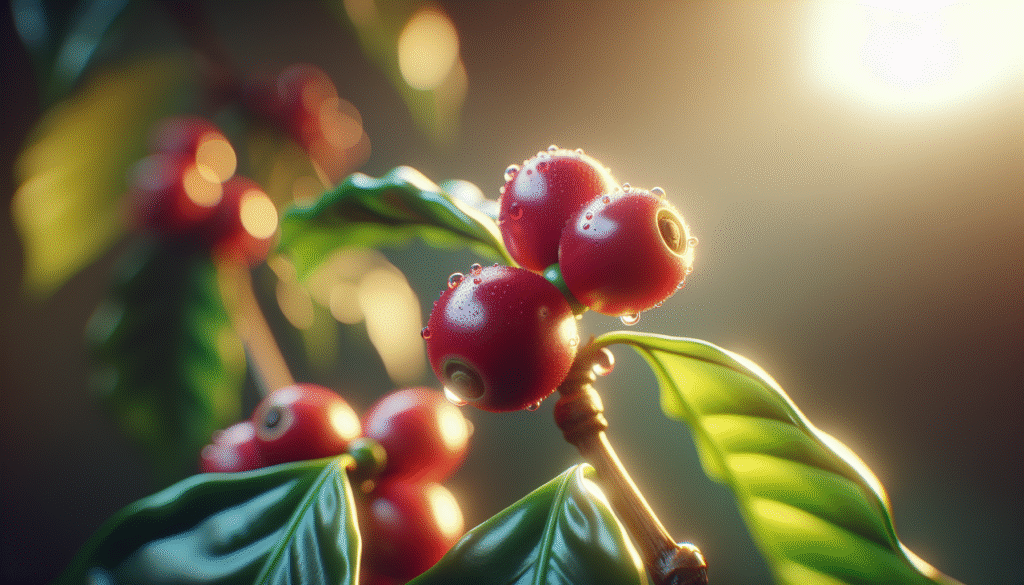Have you ever wondered how coffee grows on the farm and what steps turn a tiny seed into the cup you drink each morning?

How Coffee Grows on the Farm
This article will walk you through the full lifecycle of coffee on the farm, from planting to post-harvest handling. You’ll learn what conditions the plant needs, how farmers manage growth and quality, and what decisions influence flavor and yield.
How does coffee grow?
Coffee grows on woody shrubs or small trees that produce fragrant white flowers and red fruit called cherries. You’ll see that the process is seasonal and influenced by climate, altitude, variety, and the management practices used on the farm.
Coffee plant basics
You’ll usually encounter two main cultivated species: Coffea arabica (Arabica) and Coffea canephora (Robusta). Each has different flavor, yield, and disease-resistance characteristics, and your choices about variety will shape how you grow coffee.
Coffee plant anatomy
Knowing the plant parts helps you manage growth and troubleshoot problems. Roots gather water and nutrients, stems support structure, leaves photosynthesize, flowers signal reproductive stages, cherries contain the seeds (beans), and the seeds are what you roast and grind.
| Plant part | Function |
|---|---|
| Roots | Absorb water/nutrients, anchor plant |
| Trunk/branches | Support canopy and cherries |
| Leaves | Photosynthesis, transpiration |
| Flowers | Pollination stage, precedes cherry formation |
| Cherries | Fruit containing two seeds; indicator of ripeness |
| Seeds (beans) | Actual coffee product after processing |
Climate and geography
Coffee is sensitive to environment, so where you grow it matters a lot. You’ll find coffee farms at a range of altitudes, but ideal conditions combine mild temperatures, defined wet and dry seasons, and well-distributed rainfall.
Altitude and temperature effects
Altitude affects temperature and bean development. You’ll notice that higher altitudes usually produce denser beans with more complex flavors because cooler nights slow maturation. Arabica typically thrives between 1,000–2,000 meters above sea level, while Robusta prefers lower, warmer elevations.
Rainfall and humidity
Coffee needs sufficient rainfall (often 1,200–2,200 mm/year depending on variety and region) with distinct wet and dry periods. You’ll use the dry season for harvest and drying, while the wet season triggers vegetative growth and flowering. Excessive humidity can increase disease risk, so good farm-level drainage and airflow matter.
Soil requirements and pH
You’ll achieve the best results with deep, well-drained soils rich in organic matter. Optimal pH typically ranges from 5.5 to 6.5 for most varieties. Heavy clay or extremely alkaline soils can limit nutrient availability and root growth.
Shade vs sun
Shade-grown systems slow bean maturation, which can enhance cup quality and biodiversity on the farm. You’ll weigh shade’s benefits (microclimate moderation, ecological services) against advantages of full-sun systems (higher short-term yields but higher input and disease risk).
Varieties and genetics
Your choice of variety determines taste potential, yield, resistance to pests/diseases, and adaptation to local climate. Understanding genetics helps you plan for long-term farm resilience.
Arabica vs Robusta
Arabica generally offers higher cup quality and milder, complex flavors but is more disease-prone and lower-yielding. Robusta is hardier and produces more caffeine with a heavier-bodied flavor, often used in blends and instant coffee.
| Feature | Arabica | Robusta |
|---|---|---|
| Flavor profile | Complex, acidic, aromatic | Stronger, earthy, bitter |
| Altitude preference | Higher (1000–2000 m) | Lower (sea level to 800 m) |
| Yield | Lower | Higher |
| Disease resistance | Lower | Higher |
| Caffeine content | Lower | Higher |
Popular Arabica cultivars
You’ll find many cultivars bred for flavor or disease resistance: Typica and Bourbon (heritage, cup quality), Caturra and Catuai (compact growth), SL28 and SL34 (Kenyan quality), and disease-tolerant lines like Catimor and Sarchimor. Select varieties based on your climate, soil, and market goals.
Propagation and nursery practices
Getting good seedlings is the foundation of a productive farm. You’ll either use seeds (sexual propagation) or vegetative cuttings/grafting (clonal propagation) depending on the variety and your objectives.
Seed propagation
You’ll sow freshly harvested seeds in shaded nursery beds or trays and manage moisture carefully to encourage germination. Seedlings usually stay in the nursery for 6–12 months before transplanting to the field, allowing them to develop strong root systems.
Clonal propagation
When you want uniformity—disease resistance or consistent yield—you’ll propagate by cuttings, air-layering, or grafting from elite mother plants. Clonal plants behave predictably and maintain desired traits, but you must manage nursery hygiene to avoid disease spread.
Nursery management basics
You’ll provide shade, regular watering, and protection against pests. Harden seedlings by gradually increasing light and reducing water a few weeks before transplanting so they adapt to field conditions.
Planting on the farm
How you lay out your coffee rows and what you plant nearby affects microclimate, labor, and yields. Thoughtful planning saves resources and improves productivity.
Spacing and density
You’ll choose spacing based on variety and management intensity. Lower-density spacing (e.g., 3×3 m) reduces competition and is easier to maintain; higher-density systems (e.g., 1.5×1.5 m) can increase yield per hectare but require more inputs and pruning.
Row orientation and slope
You’ll orient rows to control erosion and maximize sunlight. On slopes, contour planting reduces runoff; on flatter land, rows can be oriented to favor uniform sunlight distribution. Proper orientation also helps mechanical access where applicable.
Intercropping and agroforestry
You’ll often intercrop coffee with shade trees, fruit trees, or nitrogen-fixing plants to improve soil health and provide additional income. Agroforestry systems can support pollinators, beneficial insects, and wildlife while protecting coffee from climatic extremes.
Care and maintenance
Ongoing field care keeps plants productive and healthy. You’ll regularly monitor nutrition, water status, canopy structure, and pest pressure.
Fertilization and nutrients
Coffee is responsive to fertilization, particularly nitrogen, phosphorus, potassium, calcium, magnesium, and micronutrients like boron and zinc. You’ll base fertilizer plans on soil tests and foliar analysis, applying nutrients split through the growing season to match demand.
Organic matter and mulching
You’ll add compost, green manures, or mulch to improve soil structure, retain moisture, and supply slow-release nutrients. Organic practices also support beneficial soil microbes that help nutrient cycling and plant health.
Irrigation and water management
In dry seasons or regions with erratic rainfall, you’ll use supplemental irrigation to avoid stress during critical periods like flowering and cherry development. Drip irrigation is efficient and lets you apply fertigation for precise nutrient delivery.
Pruning and canopy management
You’ll prune to maintain accessible canopy height, encourage new productive branches, and improve light penetration and airflow. Regular pruning cycles also help synchronize growth and facilitate harvest.
Flowering, pollination, and fruit set
Flowering is a dramatic stage, often triggered by changes in rainfall and temperature. You’ll watch flowers open in fragrant bursts, which precede cherry development.
Flowering triggers
You’ll see mass flowering after a dry period followed by rain; this stimulates synchronous bloom and ultimately a more uniform harvest window. Flower intensity and success depend on plant health and carbohydrate reserves.
Pollination and fruit set
Coffee flowers are predominantly self-fertile, but pollinators like bees can improve fruit set and uniformity. You’ll encourage pollinators by maintaining flowering cover crops and avoiding unnecessary insecticide use.
Fruit development timeline
After successful pollination, cherries develop over months; Arabica cherries often mature between 6–9 months, whereas Robusta may mature faster. You’ll plan harvest timing based on ripeness and desired processing.
| Stage | Typical duration (Arabica) | What you observe |
|---|---|---|
| Flowering | Days | White, fragrant flowers open |
| Fruit set (green cherries) | Weeks to months | Small green fruits form |
| Maturation (ripening) | 6–9 months | Cherries turn yellow → red |
| Harvest | At full ripeness | Red or deep-red cherries ready |

Pests and diseases
You’ll need integrated strategies to manage threats that can devastate yields and quality. Preventive measures and early detection are essential.
Coffee leaf rust (Hemileia vastatrix)
Leaf rust causes yellow-orange pustules and defoliation, reducing photosynthesis and yield. You’ll manage it with resistant varieties, timely pruning to improve airflow, shading adjustments, and careful fungicide use when necessary.
Coffee berry borer (Hypothenemus hampei)
This tiny beetle bores into cherries, ruining beans inside. You’ll implement monitoring, sanitation (collecting and destroying infested cherries), biological control (Beauveria bassiana), and targeted traps or insecticides to reduce infestation.
Other pests and diseases
Nematodes, root rot (Fusarium, Phytophthora in some regions), bacterial blight, and berry diseases also challenge farmers. You’ll use crop rotation, healthy seedlings, good drainage, and IPM (integrated pest management) to minimize impacts.
| Problem | Symptom | Management approaches |
|---|---|---|
| Leaf rust | Orange pustules, defoliation | Resistant varieties, pruning, fungicides, shade management |
| Berry borer | Small holes, damaged beans | Sanitation, traps, biological control, timely harvest |
| Nematodes | Root damage, stunted growth | Resistant rootstocks, organic amendments, crop rotation |
| Root-rot pathogens | Wilting, root decay | Improve drainage, remove infected plants, soil treatments |
Harvesting
You’ll harvest with timing and technique that suit your quality goals and labor availability. Harvest decisions greatly influence final cup attributes.
Picking methods
Selective hand-picking yields the highest quality because you only take ripe cherries, but it’s labor-intensive. Strip picking removes all cherries at once and is faster but mixes ripe and unripe fruit, affecting quality. Mechanical harvesters are used in flatter, larger operations, primarily with robusta or sun-grown systems.
Indicators of ripeness
You’ll determine ripeness mainly by color—deep red for many Arabica varieties. Firmness and sugar content also matter; some producers use refractometers to measure Brix in pilot batches.
Harvest frequency and labor planning
You’ll schedule several passes through the orchard during the harvest season to collect only ripe cherries. Labor management, training pickers to select ripe fruit, and proper payment systems are crucial to maintain quality and motivate workers.
Post-harvest processing
What you do immediately after harvest shapes flavor and quality. Processing removes pulp, dries the beans, and begins the flavor development process.
Main processing methods
There are three primary methods you’ll encounter: washed (wet), natural (dry), and honey (pulped natural). Each alters fermentation, sugar retention, and ultimately cup profile.
| Method | Main steps | Flavor effects | Water use |
|---|---|---|---|
| Washed (wet) | Pulping → fermentation → washing → drying | Cleaner, brighter acidity | High |
| Natural (dry) | Whole cherries dried → pulped/hulled → milling | Fruity, heavy body, complex fermentation | Low |
| Honey (pulped natural) | Pulped, mucilage left, dried → milling | Balanced sweetness, complex mouthfeel | Moderate |
Fermentation and washing
In washed processing, you’ll ferment mucilage off the beans in tanks; timing matters to avoid over-fermentation. Washing removes fermentation residues and prepares beans for even drying.
Drying
You’ll dry beans (parchment or whole cherries) to target moisture content (usually 10–12% for green coffee) using patios, raised beds, or mechanical dryers. Avoid inconsistent drying which can create mold or uneven beans.
Hulling, grading, and storage
After drying, you’ll remove the parchment or dried cherry skin, sort and grade beans by size and defects, and store them in cool, dry conditions to maintain quality. Proper storage preserves flavor until export or roasting.
Quality control and cupping
Quality begins on the farm and continues through processing. You’ll taste and test beans to ensure they meet expectations and market requirements.
Sorting and defect removal
You’ll hand-sort or use mechanical graders to remove defective beans that can cause off-flavors. Proper sorting reduces losses at roast and cup evaluation.
Cupping and scoring
You’ll use cupping protocols to evaluate acidity, body, flavor, and defects. Regular cupping helps you adjust farming and processing practices in subsequent seasons.
Yield, economics, and market factors
Coffee is both an agricultural product and a commodity. You’ll manage farm economics by balancing input costs, yields, and quality-based pricing.
Typical yields and influencing factors
Yields vary widely: smallholders with traditional systems might produce 300–1,200 kg green coffee per hectare annually, while intensive systems can exceed that. You’ll boost yields with improved varieties, fertilization, irrigation, and good management.
Price volatility and risk management
You’ll face global price swings influenced by supply, demand, and weather. Strategies like diversification, processing for specialty markets, and direct sales can buffer income variability.
Certifications and value addition
Certifications (organic, Fair Trade, Rainforest Alliance) and direct trade relationships can give you premiums for quality or sustainability. You’ll consider certification costs, record-keeping, and market access when choosing pathways.
Sustainability and environmental practices
You’ll steward the land to maintain productivity and preserve ecosystems. Sustainable practices reduce risks from climate change and can open premium markets.
Shade, biodiversity, and soil health
Shade trees increase biodiversity, reduce erosion, and can improve water retention. You’ll plant native or multipurpose shade trees that provide fruit, timber, or nitrogen fixation while supporting beneficial insects.
Water conservation and pollution control
You’ll reduce water use by optimizing processing methods and treating fermentation effluents. Constructed wetlands, composting, and recycling systems help you avoid contaminating rivers and groundwater.
Climate change adaptation
You’ll adapt by selecting resilient varieties, altering planting altitudes or microclimates, diversifying crops, and implementing water-saving measures. Monitoring weather trends and adopting flexible management practices will help you respond to changing conditions.
Mechanization and technology on the farm
Technology can increase efficiency and precision. You’ll adopt tools that fit your farm size, terrain, and budget.
Machinery and equipment
You’ll find mechanical harvesters, pulpers, graders, and dryers suited to larger or flatter farms. Smaller farms benefit from low-cost mechanization like motorized pulpers and solar dryers.
Digital tools and sensors
You’ll use soil sensors, weather stations, and farm-management apps to schedule irrigation, fertilization, and harvest. Data-driven decisions help you conserve resources and improve yields.
Common problems and troubleshooting
You’ll encounter recurring issues; rapid diagnosis and targeted interventions reduce long-term damage.
Poor flowering or low fruit set
Causes include nutrient imbalance, irregular rainfall, or poor pruning. You’ll adjust fertilization, restore carbohydrate reserves with good shade and soil care, and manage irrigation to encourage consistent flowering.
Leaf yellowing (chlorosis)
Yellow leaves often indicate nutrient deficiencies, commonly nitrogen, magnesium, or iron. You’ll conduct soil and foliar tests, apply appropriate fertilizers, and correct pH to improve nutrient availability.
Patchy ripening and low sugar in cherries
Uneven ripening can result from poor pruning, inadequate sunlight penetration, or water stress. You’ll prune for balanced canopy, ensure consistent water supply during fruit maturation, and harvest selectively to maximize sugar in cherries.
Checklist for high-quality coffee production
Use this practical checklist to guide your farm activities throughout the year:
- Choose appropriate variety for climate and market.
- Start with healthy seedlings (nursery hygiene).
- Test soil annually and adjust fertilizer based on results.
- Maintain organic matter and use mulches to conserve moisture.
- Plan planting density and shade trees suited to management capacity.
- Monitor pests and diseases; use IPM and resistant varieties.
- Time harvests to cherry ripeness; train pickers for selective picking.
- Choose processing method that fits water availability and quality goals.
- Dry to target moisture and store green coffee under proper conditions.
- Cup and evaluate regularly to align production with market demands.
Final thoughts: how you can use this knowledge
Understanding how coffee grows on the farm empowers you to make decisions that affect yield, flavor, and sustainability. Whether you’re a farmer improving practices, a student learning agronomy, or a coffee lover curious about origin, you’ll find that every choice from seed selection to processing echoes in the cup.
If you’d like, you can ask for region-specific advice (for example, how to grow coffee at a particular altitude or soil type) or a checklist tailored to smallholder or large-scale operations.



